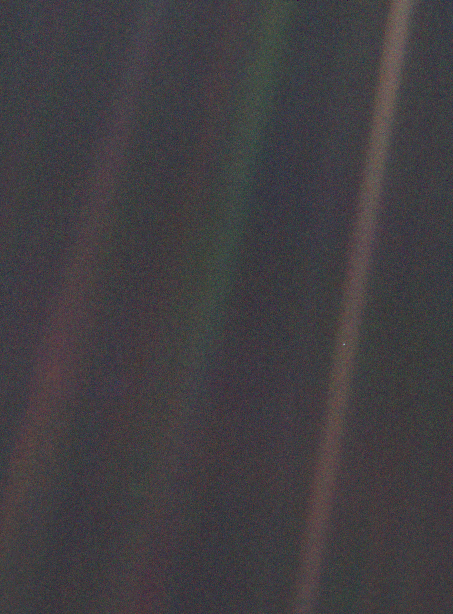The tiny point of light at right center is earth. A couple billion miles further, earth simply disappears from view.

Posted on 05/18/2022 4:02:38 PM PDT by Magnatron
The Voyager 1 probe is still exploring interstellar space 45 years after launching, but it has encountered an issue that mystifies the spacecraft's team on Earth.
Voyager 1 continues to operate well, despite its advanced age and 14.5 billion-mile distance (23.3 billion kilometers) from Earth. And it can receive and execute commands sent from NASA, as well as gather and send back science data.
But the readouts from the attitude articulation and control system, which control the spacecraft's orientation in space, don't match up with what Voyager is actually doing. The attitude articulation and control system, or AACS, ensures that the probe's high-gain antenna remains pointed at Earth so Voyager can send data back to NASA.
Due to Voyager's interstellar location, it takes light 20 hours and 33 minutes to travel one way, so the call and response of one message between NASA and Voyager takes two days.
So far, the Voyager team believes the AACS is still working, but the instrument's data readouts seem random or impossible. The system issue hasn't triggered anything to put the spacecraft into "safe mode" so far. That's when only essential operations occur so engineers can diagnose an issue that would put the spacecraft at risk.
(Excerpt) Read more at cnn.com ...
Great movie, combine that with the new Army Psyops commercial.
Sent a copy of Space Cowboys to my wife’s uncle in California. He worked on the space program and still has his condo at the Cape. His friend at Hughes was on Challenger. He was on the list to go, but wasn’t selected. After Challenger, his wife wouldn’t speak to him for a week or so. He loved the movie.
I had a physics prof who used to say, “Either when getting really tiny or getting really big, it just gets goofy.”
The tiny point of light at right center is earth. A couple billion miles further, earth simply disappears from view.

Just think, every tear that was ever shed, or love lost or fingernail broken or loved one lost....all happened within that small dot. Holy Moly.
So in other words, the “scientists” are confused again.
Wow! That’s something.
I was on the Cape and saw the Challenger launch. My aunt, father’s sister, lived in Melbourne and worked as an exec. sec. for some NASA contractor. She got me the launch pass.
It was a terrible thing but I loved the Shuttles so much I told my gf, who was with me, that I’d take a seat on one the next day if it was offered.
All the wars, people killing each other, the power hungry tyrants, all while riding on an object the size of a molecule.
Do you remember the pretty wildlife whale lover’s name?
It was neat learning about the ICs that were developed. It is amazing that the Voyager spacecraft are still going.
Had my daughter make a scaled model of the solar system. https://youtu.be/-fPm5mj0Bhg
Scaled as in: Neptune is 1km from the Sun, which was a few centimeters wide.
If we precisely understand gravity over that distance, a few times farther isn’t going to be meaningfully different.
If I’d known I was getting my picture taken, I would have worn a clean shirt that day.
It is probably sitting on a workbench on some planet where the beings are trying to figure out the messages on the disk and sending arbitrary spam back to erf.
If space is infinitely large then the neighborhood is infinitely small?
NASA should have bought the extended warranty.
Galactic neighbor just needs to borrow a cup of sugar. It’s too far to the grocery store.
Could be. And I guess it's possible mining down, the process could repeat itself indefinitely, like creating an infinite, "Inner universe". Then again, maybe not.
Male and female universes...☺
Interstellar space, high radiation? Where does that radiation come from If you’re between stars that are billions of miles apart? Must be that since there’s nothing there to stop it or slow it down it keeps going and going and going...
Thinking about distances like that gives me a slight headache.
Interstellar space, high radiation? Where does that radiation come from if you’re between stars that are billions of miles apart?
—
There is a long list: stuff like novas, supernovas, gamma ray busters, Quasars, pulsars, etc. All that from over >52 trillion known galaxies each with hundreds of millions of stars, including our own galaxy.
Disclaimer: Opinions posted on Free Republic are those of the individual posters and do not necessarily represent the opinion of Free Republic or its management. All materials posted herein are protected by copyright law and the exemption for fair use of copyrighted works.